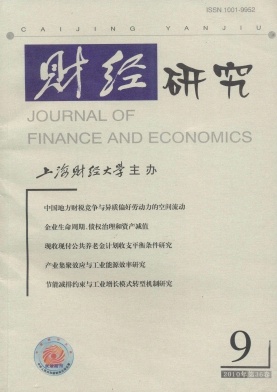产业集聚效应与工业能源效率研究——基于中国25个工业行业的实证分析
财经研究 2010 年 第 36 卷第 09 期, 页码:70 - 80
摘要
参考文献
摘要
文章从外部性的角度探讨了能源效率的影响因素。鉴于产业外部性即产业集聚会促进经济增长、全要素生产率的已有研究,文章提出了产业集聚也可以提高能源效率的假说,并借助中国2001-2007年25个工业行业的数据,采用DEA的方法测度了全要素(各类)能源效率以及产业集聚程度指标。结果发现能源密集型行业的全要素能源效率较低,而能源非密集型行业全要素能源效率较高;资源依赖性行业及出口密集型等行业集聚程度较高;烟草行业的能源效率和集聚程度均居首位。随后文章采用实证的方法验证了产业集聚及其所引致的外部性可以有效提高全要素能源效率和单要素能源效率的假说。
[1]董利.我国能源效率变化趋势的影响因素分析[J].产业经济研究,2008,(1):8-18.
[2]范剑勇.产业集聚与地区间劳动生产率差异[J].经济研究,2006,(11):72-81.
[3]孔婷,孙林岩,何哲,孙荣庭.能源价格对制造业能源强度调节效应的实证研究[J].管理科学,2008,(3):2-8.
[4]史丹.中国能源效率的地区差异与节能潜力分析[J].中国工业经济,2006,(10):49-58.
[5]师博,沈坤荣.市场分割下的中国全要素能源效率:基于超效率DEA方法的经验分析[J].世界经济,2008,(9):49-59.
[6]魏楚,沈满洪.能源效率与能源生产率:基于DEA方法的省际数据比较[J].数量经济与技术经济研究,2007a,(9):110-121.
[7]魏楚,沈满洪.能源效率及其影响因素:基于DEA的实证分析[J].管理世界,2007b,(8):66-76.
[8]魏楚.中国能源效率问题研究[D].浙江大学,2009.
[9]杨正林.中国能源效率的影响因素研究[D].华中科技大学,2009.
[10]赵伟,张萃.FDI与中国制造业区域集聚:基于20个行业的实证分析[J].经济研究,2007,(11):82-90.
[11]张宇,蒋殿春.FDI、产业集聚与产业技术进步——基于中国制造行业数据的实证检验[J].财经研究,2008,(1):72-82.
[12]周兵,蒲勇健.一个基于产业聚集的西部经济增长实证分析[J].数量经济技术经济研究,2003,(8):143-147.
[13]Andrew Warren.Does energy efficiency save energy:The i mplications of accepting theKhazzoom-Brookes Postulate[EB/OL].http://technology.open.ac.uk/eeru/staff/horace/kbpotl.ht ml,1982.
[14]Andreoni J,A Levinson.The si mple analytics of the environmental Kuznets Curve[J].Journal of Public Economics,2001,80(2):269-286.
[15]Boyd Gale,A Pang,Joseph X.Esti mating the linkage between energy efficiency andproductivity[J].Energy Policy,2000,28(5):289-296.
[16]Charnes A,Cooper W W,Rhodes E.Measuring the efficiency of decision making unites[J].European Journal of Operational Research,1978,(2):429-444.
[17]Cingano F,Schivardi F.Identifying the sources of local productivity growth[J].Journalof the European Economic Association,2004,(2):720-742..
[18]Copeland B,S Taylor.Trade and the environment[M].NewJersey:Princeton Univer-sity Press,2003.
[19]Fare R,S Grosskopf,Carl A Pasurka.Environmental productionfunctions and environ-mental directional distance functions[J].Energy,2007,(32):1055-1066.
[20]Hallet Martin.Regional specialization and concentration in the EU[R].Economic Pa-pers,No.141,2000.
[21]Henderson V.The sizes and types of cities[J].American Economic Review,1974,64(4):640-656.
[22]Hu J L,Wang S C.Total-factor energy efficiency of regions in China[J].Energy Pol-icy,2006,(34):3206-3217.
[23]Karen Fisher-Vanden,Gary HJefferson,Ma J ingkui,Xu J ianyi.Technology devel-opment and energy productivity in China[J].Energy Economics,2006,28(3):690-705.
[24]Ki m S.Expansion of markets and the geographic distribution of economic activities:The trends in U.S.regional manufacturing structure,1860-1987[J].Quarterly Journalof Economics,1995,110(4),881-908.
[25]Krugman Paul.Increasing returns and economic geography[J].Journal of Political E-conomy,1991a,99(3),483-499.
[26]Krugman P.Geography and trade[M].MIT Press.1991b.
[27]Marshall A.Principles of economics[M].New York:Mac Millan,1920.
[28]MJ Farrell.The measurement of productive efficiency[J].Journal of the Royal Statis-tical Society,1957,120(3):253-290.
①关于全要素能源效率和单要素能源效率的详细区别,请参见魏楚、沈满洪(2007)。
②关于分析对能源效率影响因素的文献可参见:刘畅等(2008),孔婷等(2008),Fisher-Vanden(2004),Lei ming Hang(2007),李未无(2008),董利(2008),滕玉华、陈小霞(2009),师博、沈坤荣(2008)等。
③事实上,产业集聚及其所带来的外部性不仅对经济增长、全要素生产率有着促进的作用,甚至还会产生外部规模经济以提高产业的减污技术进而降低污染排放强度(Copel-and和Taylor,2003;Andreoni和Levinson,2001)。
[2]范剑勇.产业集聚与地区间劳动生产率差异[J].经济研究,2006,(11):72-81.
[3]孔婷,孙林岩,何哲,孙荣庭.能源价格对制造业能源强度调节效应的实证研究[J].管理科学,2008,(3):2-8.
[4]史丹.中国能源效率的地区差异与节能潜力分析[J].中国工业经济,2006,(10):49-58.
[5]师博,沈坤荣.市场分割下的中国全要素能源效率:基于超效率DEA方法的经验分析[J].世界经济,2008,(9):49-59.
[6]魏楚,沈满洪.能源效率与能源生产率:基于DEA方法的省际数据比较[J].数量经济与技术经济研究,2007a,(9):110-121.
[7]魏楚,沈满洪.能源效率及其影响因素:基于DEA的实证分析[J].管理世界,2007b,(8):66-76.
[8]魏楚.中国能源效率问题研究[D].浙江大学,2009.
[9]杨正林.中国能源效率的影响因素研究[D].华中科技大学,2009.
[10]赵伟,张萃.FDI与中国制造业区域集聚:基于20个行业的实证分析[J].经济研究,2007,(11):82-90.
[11]张宇,蒋殿春.FDI、产业集聚与产业技术进步——基于中国制造行业数据的实证检验[J].财经研究,2008,(1):72-82.
[12]周兵,蒲勇健.一个基于产业聚集的西部经济增长实证分析[J].数量经济技术经济研究,2003,(8):143-147.
[13]Andrew Warren.Does energy efficiency save energy:The i mplications of accepting theKhazzoom-Brookes Postulate[EB/OL].http://technology.open.ac.uk/eeru/staff/horace/kbpotl.ht ml,1982.
[14]Andreoni J,A Levinson.The si mple analytics of the environmental Kuznets Curve[J].Journal of Public Economics,2001,80(2):269-286.
[15]Boyd Gale,A Pang,Joseph X.Esti mating the linkage between energy efficiency andproductivity[J].Energy Policy,2000,28(5):289-296.
[16]Charnes A,Cooper W W,Rhodes E.Measuring the efficiency of decision making unites[J].European Journal of Operational Research,1978,(2):429-444.
[17]Cingano F,Schivardi F.Identifying the sources of local productivity growth[J].Journalof the European Economic Association,2004,(2):720-742..
[18]Copeland B,S Taylor.Trade and the environment[M].NewJersey:Princeton Univer-sity Press,2003.
[19]Fare R,S Grosskopf,Carl A Pasurka.Environmental productionfunctions and environ-mental directional distance functions[J].Energy,2007,(32):1055-1066.
[20]Hallet Martin.Regional specialization and concentration in the EU[R].Economic Pa-pers,No.141,2000.
[21]Henderson V.The sizes and types of cities[J].American Economic Review,1974,64(4):640-656.
[22]Hu J L,Wang S C.Total-factor energy efficiency of regions in China[J].Energy Pol-icy,2006,(34):3206-3217.
[23]Karen Fisher-Vanden,Gary HJefferson,Ma J ingkui,Xu J ianyi.Technology devel-opment and energy productivity in China[J].Energy Economics,2006,28(3):690-705.
[24]Ki m S.Expansion of markets and the geographic distribution of economic activities:The trends in U.S.regional manufacturing structure,1860-1987[J].Quarterly Journalof Economics,1995,110(4),881-908.
[25]Krugman Paul.Increasing returns and economic geography[J].Journal of Political E-conomy,1991a,99(3),483-499.
[26]Krugman P.Geography and trade[M].MIT Press.1991b.
[27]Marshall A.Principles of economics[M].New York:Mac Millan,1920.
[28]MJ Farrell.The measurement of productive efficiency[J].Journal of the Royal Statis-tical Society,1957,120(3):253-290.
①关于全要素能源效率和单要素能源效率的详细区别,请参见魏楚、沈满洪(2007)。
②关于分析对能源效率影响因素的文献可参见:刘畅等(2008),孔婷等(2008),Fisher-Vanden(2004),Lei ming Hang(2007),李未无(2008),董利(2008),滕玉华、陈小霞(2009),师博、沈坤荣(2008)等。
③事实上,产业集聚及其所带来的外部性不仅对经济增长、全要素生产率有着促进的作用,甚至还会产生外部规模经济以提高产业的减污技术进而降低污染排放强度(Copel-and和Taylor,2003;Andreoni和Levinson,2001)。
引用本文
王海宁, 陈媛媛. 产业集聚效应与工业能源效率研究——基于中国25个工业行业的实证分析[J]. 财经研究, 2010, 36(9): 70–80.
导出参考文献,格式为:
本期封面
相关论文





 7768
7768  4094
4094

